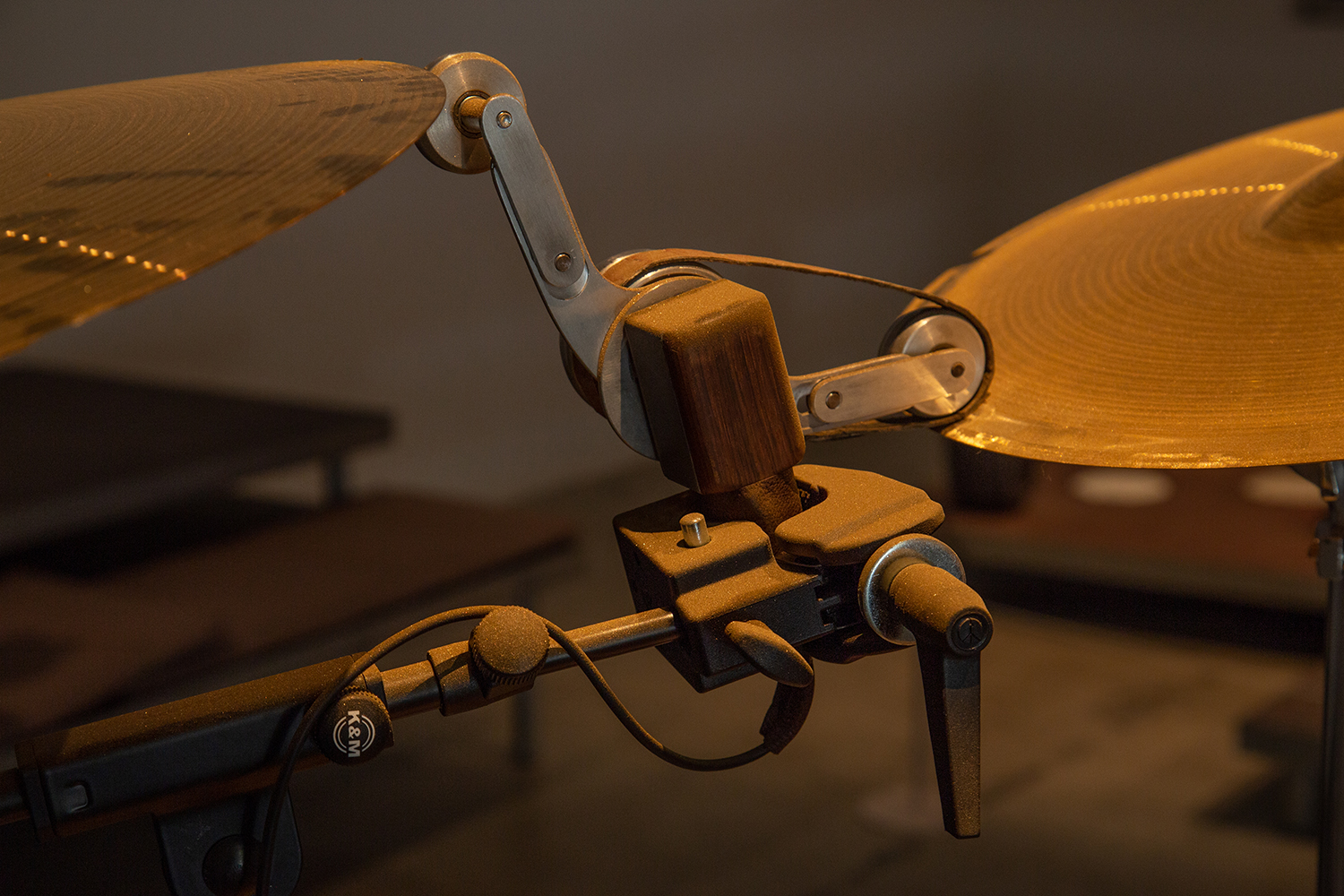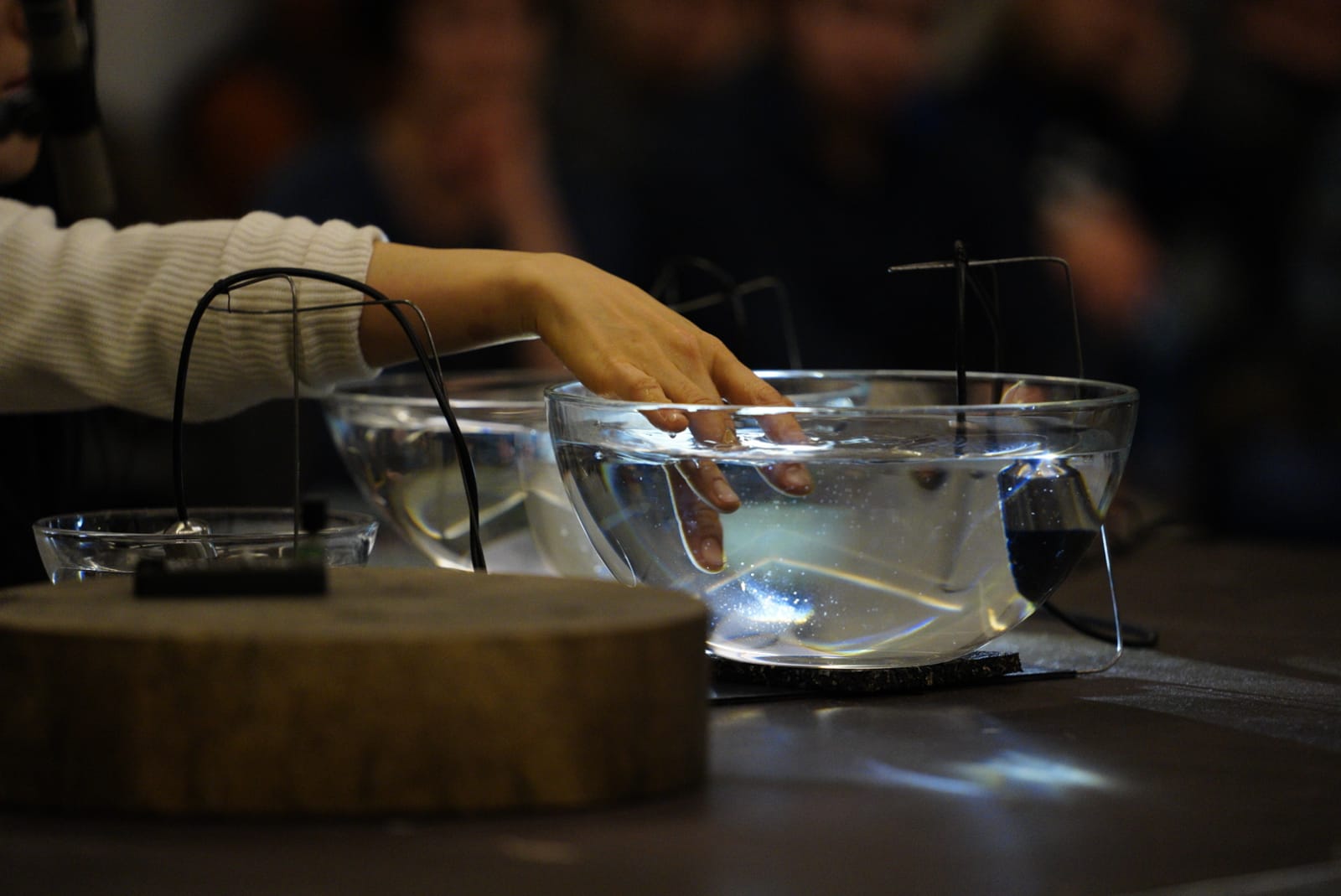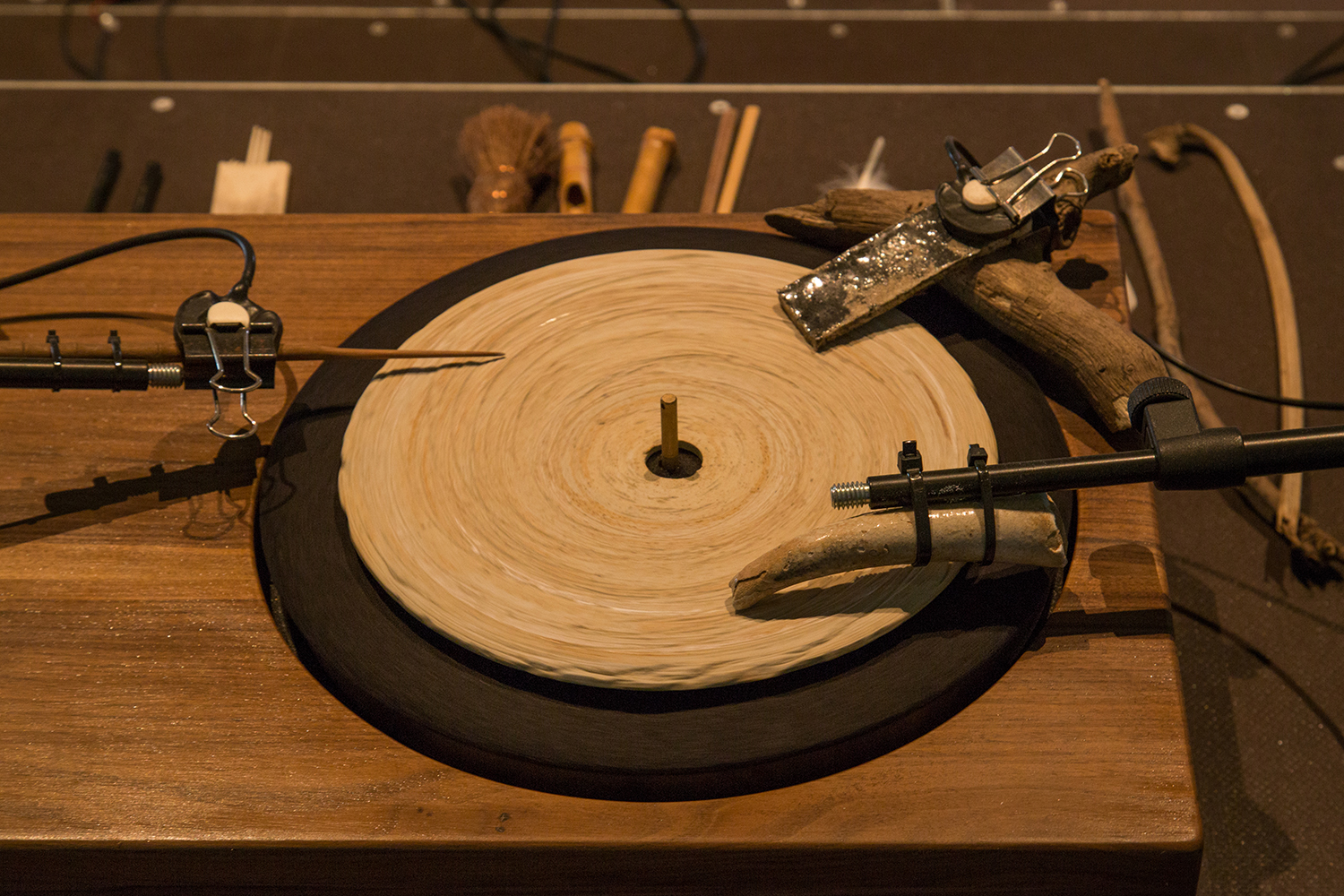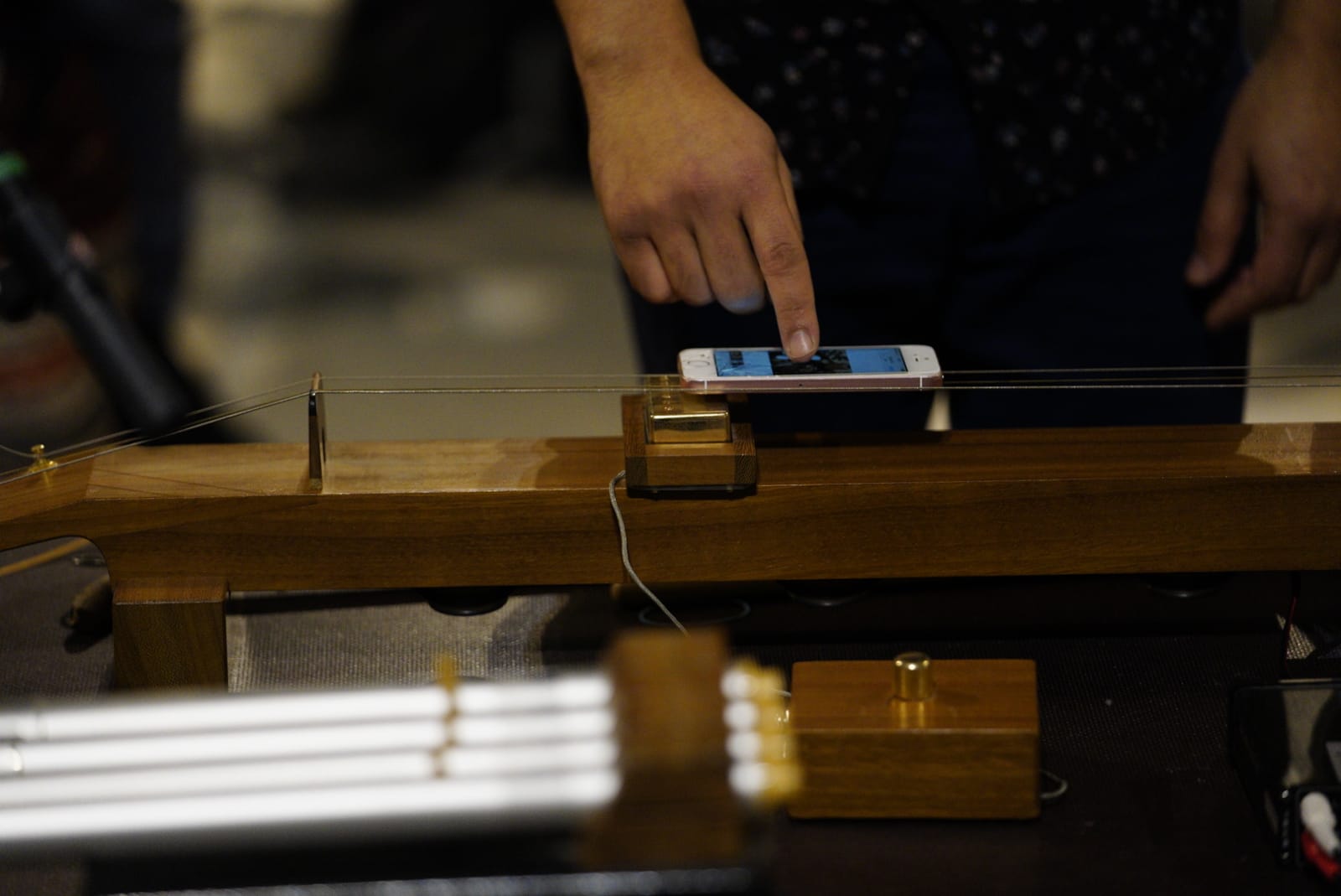Tarek Atoui: Sessions

I met Tarek Atoui immediately after the performance by Uriel Barthélémi staged at Palazzo Grassi in November, over the wonderful Luc Tuymans mosaic prematurely removed after that day because of the high water of the previous week. The scenery was intense, the lights were dimmed and people moved quickly following the perfomer between the two stations. There were those who paused to observe and discern the different instruments that made up the session, those who closed their eyes and let the sound pervade their space of thought, and those who watched both the firsts and the seconds, enjoying the sound and the surrounding scene. We started from there to make a wider speech including his presence at the last Venice Biennale and his on-going projects.
Simone Rossi: I would like to start by talking about The Ground, on the relationship between your performative installation at La Biennale and The Sessions, in particular the one presented at Palazzo Grassi on November 20th, and performed by the electroacoustic composer Uriel Barthélémi.
Tarek Atoui: The form that The Ground assumed at the Arsenale of La Biennale derives from many performances and experimentations that my collaborators and I did with the instruments, as long as they were created and developed. After a year of performing with these instruments, I was able to make a synthesis of techniques, sound ideas, things that the musicians brought by responding to the invitations I gave them: all this inspired the piece at La Biennale. Now, The Ground Sessions are proposing this again and bringing things back to their origin, but where the piece becomes order, the composition-installation becomes the score for new performances to have. And so, in The Ground Sessions you will see the ideas that are within the installation in La Biennale explode and magnify; sometimes really small sounds in the piece become layers for other things or relationships between instruments turning, exploring further, for example, the relation between percussion and the sound of fluids. These things are beginning to become guidelines for improvisation.
Each session has a different interpretation; Uriel’s was about the relationship of the instruments to each other; the musicians’ interpretation of the following day’s performance at the Teatrino di Palazzo Grassi was about the component of space, how two spaces can dialogue with each other according to the idea that they are already in the composition.
SR: The performances by U. Barthélémi and the one of the day after played by the musicians Alan Affichard, Igor Porte, Rosario Sorbello and Tomoko Sauvage together with Daniel Araya shared instruments but took place in different spaces, both so semiotically connoted. How do you balance this out? How do you you deal with space and display?
TA: Spatial configuration is a fundamental part of the proposal of what you are trying to communicate. I see these two performances through the idea of a soul that splits into two sessions in dialogue with each other, as a shell that unfolds and opens up towards the next session. But in the configuration from one person to five people – at the Teatrino you see that the five people are divided into three men in front of one woman and one man at the bottom of the theater – the woman has the central role, everything unfolds according to her. These places are already narrating and talking about a specific situation and prolong this feature by incorporating our flow so that from the core of Uriel we move to the core of Tomoko and the four people who surround her.
 SR: These kind of performances are a moment in which heterogeneous times meet together; past merges into present, giving it a new meaning as if it were already preserving a sort of tactile, imagery and sound memory. How does your artistic practice act and reflect on and over time?
SR: These kind of performances are a moment in which heterogeneous times meet together; past merges into present, giving it a new meaning as if it were already preserving a sort of tactile, imagery and sound memory. How does your artistic practice act and reflect on and over time?
TA: I’m really interested in accumulated time and experience. I don’t like to read things and start from scratch. Everything I do – more generally in my practice – binds to other works; ideas flow and circulate, and this comes from a composer mentality that doesn’t prevent you from using the pre-existing material taking it from one project to another, as in continuous navigation. This accumulated experience is built up by inviting many people to collaborate, working with these peculiar instruments, moving from residencies to performances up to research, and then transforming all this into composition, making new performances, accumulating all this.
As you said, there is the memory of the instrument that contains the vibrations of the musician who played it, especially for those made of wood or organic materials, but there is also the memory of the object that people have brought, techniques or ideas that have modified it, and all this is important to be re-injected each time in a new way.
I find that in contemporary art we are often tempted to start from a black page, every time someone starts something he/she/they make a tabula rasa of what happened before then, whether it is to create an exhibition or rather to work site-specifically or to involve a certain audience. When I compose, instead, I am very focused on knowing what happened before and how to build on what is already here. This notion of time as sustain is very important.
SR: You are used to collaborating with all kinds of sound related figures. This gives an added value to your projects that originate with the desire to open up to an external gaze and touch. This basic openness strike the public who, in my opinion, feels this willingness of your practice to enter into communication. Is the performing sound experience a sort of new dialogue that you want to create, a way to get closer to people?
TA: Yes, certainly performances have always been like a drive and guide; even if you work with new or contemporary music, or abstract sound, the performativity already reaches people as an open gesture; as with Uriel, that we invited people to walk in space. It is difficult, perhaps it is better sometimes to be seated and listen not necessarily in motion, but this formula comes from a form of generosity, which offers people the opportunity to mix and freely understand how to deal with the situation, take what they want and leave the rest.
 SR: Indeed, your performances have a physical and tactile dimension while preserving the incredible ability of sound to abstract.
SR: Indeed, your performances have a physical and tactile dimension while preserving the incredible ability of sound to abstract.
TA: They combine physical, visual, sonic and metaphysical values. It is something I experienced before this, when I was working on a project with deaf people. The idea behind sharing was not to create a space where everyone could hear the same things, it was about offering a situation of enrichment from which to draw something according to one’s abilities. It’s not about homogenizing the experience, everyone can feel the performance in a different way.
SR: The multisensory dimension in your practice is partly structured, while on the other hand it is the result of improvisation in space and time. How does sound relate to chance, to the unexpected, to the contingent? Is there a deeper order or should we go beyond this kind of dichotomy?
TA: For me there is no dichotomy in reality; improvisation is fundamental in what I do. All those things that are written or scripted are in relation to improvisation. Scripting or scoring is a way to allow improvisation to arrive in an optimal way, it is not to force it but to allow unexpected things to happen, collaborating with performers and their feelings that are part of the show – they are not mere executors – this is the way I mean contemporary composition today. There is nothing without improvisation in what I offer, and it doesn’t mean that you have to be a virtuoso, it’s just a matter of daring to listen, humble attitude in front of the sound, and then making the decision on where to go with respect to what you are perceiving. This openness is fundamental and today it would be too limiting to stop at a dichotomous sense. You would be especially amazed about the experiences of The Ground as a composition in space; even I was personally impressed when I did it by how our brain deafens and orders information. Even if you get synchronous layers of sound your brain restructures them according to cultural, educational ideas of how to listen to music, and according to your personal point of view the whole takes on meaning and this is incredibly beautiful; the experience offers a vast multisensorial landscape that is absorbed and ordered in a personal, proper and expressive different way for each of the listeners.
 SR: The Ground comes from a 6-year-long research and travel work carried out mainly in China, in the Pearl River Delta, which you then moved to Singapore, Guangdong and to Europe. What carry on motivating and inspiring your daily research on The Ground today? Now, is there a new research-based project on the horizon?
SR: The Ground comes from a 6-year-long research and travel work carried out mainly in China, in the Pearl River Delta, which you then moved to Singapore, Guangdong and to Europe. What carry on motivating and inspiring your daily research on The Ground today? Now, is there a new research-based project on the horizon?
TA: That’s where I’m stuck now (laughing). Since I have made the composition at the Arsenale, The Ground, as a work, is over. The composition is now a space for listening, an attitude of listening to the public, addressed to the performers, to the proponents who come after; this is the score of what will come. So now I invite the musicians to perform and the composers to write the pieces, I invite them first of all to listen to the composition and to get an idea: it’s a visual, graphic and meta score.
For The Ground in the future I’m conducting sessions like these at Palazzo Grassi where I don’t even perform, the principles of working with The Ground are becoming simpler and simpler as the piece becomes more complex and this is extremely valuable. You feel like you’re achieving something. As composition, it will always be unfinished but can be deployed in new spaces and time with other objects and materiality; it could happen in Peru next time, who knows?
SR: All in all, your Venetian experience is quite over – Biennale is actually over. What do take with you about this period and scenario?
TA: This chapter in Venice was crucial in my practice and work; having reached this level of composition after such a long period of research on the project is a new step in my career with enormous possibilities for the future. I would already like to start manifesting in other special pieces, so as to revisit previous works.
Even though we are at the end of La Biennale, I don’t think I have finished with The Ground here; even if it doesn’t happen in Venice it will continue elsewhere, and it will still be connected to Venice, coming from here in the same way that comes from Guangdong. The Venetian experience was not only about coming and showing something that was done, but also about going further, reaching new stages; I think I have been very lucky, it doesn’t happen to everyone here.
